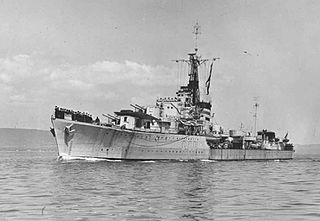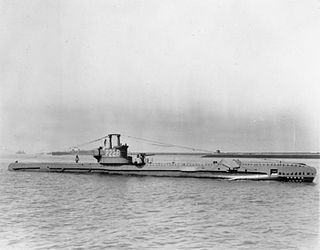
HMS Cairo (D87) was a C-class light cruiser of the Royal Navy, named after the Egyptian capital, Cairo. So far she has been the only ship of the Royal Navy to bear the name. She was part of the Carlisle group of the C-class of cruisers.

HMS Kenya was a Fiji-class cruiser of the Royal Navy. The ship was named after Kenya, a British possession at the time of the ship's construction.

HMS Jervis, was a J-class destroyer built for the Royal Navy in the late 1930s. She was named after Admiral John Jervis (1735–1823). She was laid down by R. and W. Hawthorn, Leslie and Company, Limited, at Hebburn-on-Tyne on 26 August 1937. The ship was launched on 9 September 1938 and commissioned on 8 May 1939, four months before the start of the Second World War.

HMS Antelope was a British A-class destroyer, which was completed for the Royal Navy in 1930. Antelope served throughout the Second World War, taking part in the sinking of three enemy submarines and in Operation Torch, the Allied invasion of French North Africa.

HMS Legion was an L-class destroyer of the Royal Navy. She entered service during the Second World War, and had a short but eventful career, serving in Home waters and the Mediterranean. She was sunk in an air attack on Malta in 1942. The ship had been adopted by the British civil community of the Municipal Borough of Cheltenham, Gloucestershire in November 1941.

HMS Sirius was a Dido-class light cruiser of the Royal Navy. She was built by Portsmouth Dockyard, with the keel being laid down on 6 April 1938. She was launched on 18 September 1940, and commissioned 6 May 1942.

HMS Splendid was a third-batch S-class submarine built for the Royal Navy during World War II. She was laid down on 7 March 1941 and launched on 19 January 1942. After an initial patrol through the Bay of Biscay to Gibraltar, Splendid conducted two patrols in the Mediterranean Sea; one was abandoned after technical problems and on the other she sank two Italian ships. On her next patrol, the submarine attacked two Italian convoys, sinking an Italian destroyer in the second attack. Based in Algiers, the boat operated north of Sicily, sinking six Italian ships, including two tankers and two heavy merchant ships. Splendid was detected by a German destroyer on 21 April 1943 while patrolling off Naples, Italy; the submarine was attacked with depth charges by the destroyer and forced to surface, after which she was scuttled and her surviving crew members taken prisoner. She was the most successful British submarine by tonnage sunk between November 1942 and May 1943.

HMS Sickle was a third-batch S-class submarine built for the Royal Navy during World War II. Completed in 1942, she made her initial war patrol off the Norwegian coast. Sickle then sailed to Gibraltar, from where she conducted one patrol, then to Algiers, French North Africa. From 10 May to 10 October, the boat patrolled the Gulf of Genoa five times and sank a German submarine as well as three minesweepers and an escort ship. She then moved to Beirut, French Lebanon, and conducted two patrols in the Aegean Sea, sinking three caïques and a merchant ship, in addition to landing resistance operatives in Greece.

HMS Sportsman was a third-batch S-class submarine built for the Royal Navy during World War II. Completed in 1942, she spent most of the war serving in the Mediterranean Sea. After an initial patrol off Norway, she sank the heavy transport Général Bonaparte in the Mediterranean in 1943 and missed a French oil tanker. She was heavily damaged after a mistaken attack by an Allied bomber, and was sent east after repairs to participate in operations in the Black Sea. After the operation was cancelled, Sportsman patrolled the Aegean Sea, sending several Greek and German ships to the bottom. She sank the German transport SS Petrella in early 1944 despite it being clearly marked as a prisoner-of-war ship, killing 2,670 out of 3,173 Italians aboard. Sportsman sank several more ships, and suffered minor damage when she was detected and sighted while attempting to attack a convoy.

The second HMS Talisman (N78), and the first to enter service under the name, was a T-class submarine of the Royal Navy. She was laid down by Cammell Laird & Co Limited, Birkenhead and launched on 29 January 1940.

HMS Tetrarch (N77) was a T-class submarine of the Royal Navy. She was laid down by Vickers Armstrong, Barrow and launched in November 1939.

HMS Tigris was a T-class submarine of the Royal Navy. She was laid down at Chatham Dockyard and launched in October 1939.

HMS Ursula was a U-class submarine, of the first group of that class constructed for the Royal Navy. The submarine entered service in 1938 and saw action during the Second World War in the North and Mediterranean Seas.

HMS Unrivalled (P45) was a U-class submarine built for the Royal Navy during World War II. The boat has been the only ship of the Royal Navy to ever bear the name Unrivalled. Completed in 1942, the boat spent most of the war in the Mediterranean. She sank a number of small merchant ships and naval auxiliaries, but major success eluded her during the war. Too small and slow for the post-war environment, Unrivalled was scrapped in 1946.

HMS Anthony was an A-class destroyer of the Royal Navy. She served in the Second World War.

HMS Lively was an L-class destroyer of the Royal Navy. She served during the Second World War, and was sunk in the Mediterranean in an air attack on 11 May 1942.

HMS Stork (L81) was a Bittern-class sloop of the Royal Navy. She was active during the Second World War, serving in convoy escort groups, and was a successful anti-submarine warfare vessel, being credited with the destruction of four U-boats.

HMS Watchman was a W-class destroyer of the British Royal Navy that saw service in the final months of World War I, in the Russian Civil War, and in World War II.

The third HMS Windsor (D42) was a W-class destroyer of the British Royal Navy that saw service in the final months of World War I and in World War II.

Freccia was the lead ship of her class of four destroyers built for the Regia Marina in the early 1930s. Completed in 1931, she served in World War II and previous conflicts.





















